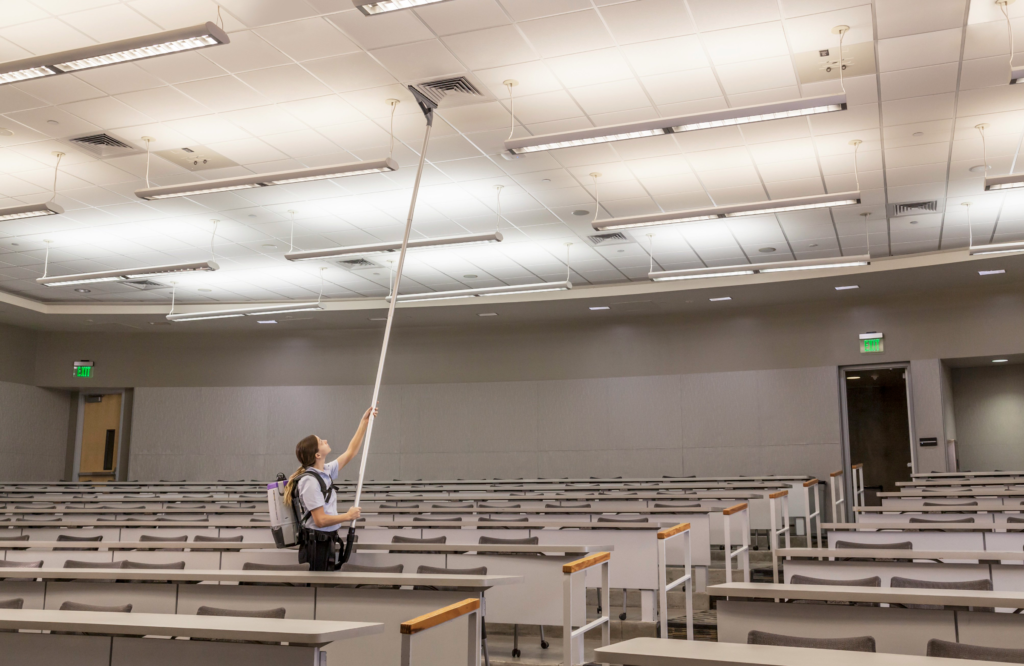High dusting and low dusting are terms used in cleaning services to describe the areas being cleaned in a building, particularly in reference to their height and accessibility. Let’s compare the key aspects of high dusting vs low dusting in cleaning services.
Table of Contents
High Dusting
High dusting refers to cleaning hard-to-reach areas that are usually above normal reach, generally about 8 feet or higher from the ground and is usually a part of a deep cleaning. This includes cleaning:
- Vents and ceiling fans
- Top surfaces of cabinets
- High shelves
- Above door frames
- Light fixtures
- Ductwork and pipes
- Ceiling corners to remove cobwebs

High dusting is crucial for removing dust, allergens, and other particles that accumulate in these less-accessible spots, which can affect air quality and overall cleanliness. It often requires special equipment like ladders, long dusters, or even scissor lifts, making it a task usually performed by professionals.
Low Dusting
Low dusting involves cleaning surfaces and areas that are easily reachable and commonly interacted with. This usually involves areas below 8 feet, such as:
- Baseboards
- Desks and tabletops
- Window sills
- Chair rails
- Low shelves
- Electrical appliances at lower levels
Purpose and Importance: Low dusting helps maintain a visibly clean environment, removes common dust and debris, and is essential for the health and hygiene of the space. It’s typically easier to perform and doesn’t require specialized equipment, making it a common part of routine cleaning tasks.
Comparison and Usage
| Aspect | High Dusting | Low Dusting |
|---|---|---|
| Height | Above 8 feet from the ground | Below 8 feet from the ground |
| Areas Covered | – Vents and ceiling fans – Top surfaces of cabinets – High shelves – Above door frames – Light fixtures – Ductwork and pipes – Ceiling corners for cobwebs | – Baseboards – Desks and tabletops – Window sills – Chair rails – Low shelves – Electrical appliances at lower levels |
| Equipment Needed | Special equipment like ladders, long dusters, scissor lifts | Generally requires standard cleaning tools like cloths, dusters, and mops |
| Purpose | Removes dust, allergens, and particles from hard-to-reach areas, affecting air quality | Maintains visible cleanliness and hygiene in frequently used and easily accessible areas |
| Frequency | Less frequent due to difficulty and lesser direct interaction with the environment but crucial for overall air quality | More frequent as these areas accumulate visible dust and debris quickly and are used more regularly |
| Importance | Essential for maintaining good air quality, especially in settings with air quality concerns like hospitals or offices | Crucial for everyday hygiene and aesthetics, particularly in areas with high foot traffic |
Both high and low dusting are essential for comprehensive cleaning, as dust can accumulate on both high and low areas. Ignoring high dusting can lead to the buildup of dust mites and allergens, which can circulate through HVAC systems, while neglecting low dusting can quickly make a space look untidy and neglected. Regular attention to both high and low areas ensures a thoroughly clean and hygienic environment, which is especially important in places like hospitals, offices, and schools.
Depending on the setting and the presence of individuals with allergies or respiratory issues, it may be necessary to perform high dusting more frequently to maintain air quality. Meanwhile, low dusting might be required more regularly in high-traffic areas to manage visible cleanliness and hygiene.
-
Deep Cleaning in Honolulu: Regular vs Deep Cleaning
-
Cleaning for the Allergy: High Dusting vs Low Dusting
-
Determining Your Cleaning Needs: A Guide